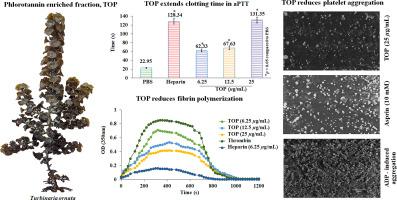Phlorotannin from Turbinaria ornata exhibits anticoagulant and antiplatelet activity: A promising natural resource for thrombotic disorder management
IF 4.5
2区 生物学
Q1 BIOTECHNOLOGY & APPLIED MICROBIOLOGY
Algal Research-Biomass Biofuels and Bioproducts
Pub Date : 2025-10-01
DOI:10.1016/j.algal.2025.104309
引用次数: 0
Abstract
Phlorotannins derived from the brown macroalga Turbinaria ornata exhibit anticoagulant and antiplatelet activity, making them a promising natural resource for functional foods targeting thrombotic disorders. The phlorotannin extract (TOC), identified as a mixture of eckols, fuhalols, and carmalol derivatives, exhibited a total phenolic content of 141.3 mg GAE/g and a phlorotannin content of 21.1 mg PGE/g (p < 0.05). Further purification of TOC with Amberlite XAD-16 resin produced a phlorotannin-rich fraction (TOP), exhibiting an elevated total phenolic content (171.2 mg GAE/g) and phlorotannin content (38.2 mg PGE/g). Bioactivity assessment revealed that TOP exhibited potent antioxidant activity (IC50 ⁓ 0.2 mg/mL) and significant anticoagulant properties. TOP (25 μg/mL) significantly prolonged coagulation times by increasing activated partial thromboplastin time (aPTT) from 22.95 s to 131.35 s and prothrombin time (PT) from 23.90 s to 86.02 s. In thrombin-induced human umbilical vein endothelial cells (HUVECs), TOP (6.25–25 μg/mL) reduced intracellular calcium mobilization by 22.8–50 % and fibrin polymerization by 36.7–59.4 % in plasma. Additionally, TOP (6.25–25 μg/mL) decreased the fluorescent intensities of phosphorylated MARCKS (p-MARCKS) and factor Xa (FXa) by 18.2–74.9 % and 43.1–85.2 %, respectively (p < 0.05). In a dose-dependent manner, TOP (6.25–25 μg/mL) inhibited total thrombin production by 20.5–60.3 %. Furthermore, TOP (6.25–25 μg/mL) reduced adenosine diphosphate (ADP)-induced platelet aggregation by 18.14–63.97 % and induced structural changes in platelets, promoting a less aggregated state. The ability of phlorotannins to modulate both intrinsic and extrinsic coagulation cascades highlights the therapeutic potential of TOP in regulating clot formation and preventing vascular damage, thereby warranting further molecular and clinical investigations.

从鸟鼻甲中提取的绿单宁具有抗凝血和抗血小板活性:一种有前途的用于血栓性疾病管理的天然资源
从褐藻Turbinaria ornata中提取的叶绿素单宁具有抗凝血和抗血小板活性,使其成为针对血栓性疾病的功能食品的有前途的天然资源。叶绿素素提取物(TOC)由酚类、全酚类和卡麦洛酚衍生物组成,总酚含量为141.3 mg GAE/g,叶绿素素含量为21.1 mg PGE/g (p < 0.05)。用Amberlite XAD-16树脂进一步纯化TOC,得到富绿皮单宁的组分(TOP),总酚含量(171.2 mg GAE/g)和绿皮单宁含量(38.2 mg PGE/g)升高。生物活性评价表明,TOP具有较强的抗氧化活性(IC50⁓0.2 mg/mL)和显著的抗凝血性能。TOP (25 μg/mL)显著延长凝血时间,使活化的部分凝血活素时间(aPTT)从22.95 s增加到131.35 s,凝血酶原时间(PT)从23.90 s增加到86.02 s。在凝血素诱导的人脐静脉内皮细胞(HUVECs)中,TOP (6.25 ~ 25 μg/mL)可使血浆中细胞内钙动员减少22.8% ~ 50%,纤维蛋白聚合减少36.7% ~ 59.4%。此外,TOP (6.25 ~ 25 μg/mL)可使磷酸化的MARCKS (p-MARCKS)和Xa因子(FXa)的荧光强度分别降低18.2 ~ 74.9%和43.1 ~ 85.2% (p < 0.05)。TOP (6.25 ~ 25 μg/mL)对总凝血酶产生的抑制作用为20.5 ~ 60.3%,呈剂量依赖性。此外,TOP (6.25 ~ 25 μg/mL)可使二磷酸腺苷(adenosine diphosphate, ADP)诱导的血小板聚集减少18.14 ~ 63.97%,并引起血小板结构改变,促进血小板低聚集状态。紫单宁调节内源性和外源性凝血级联的能力突出了TOP在调节凝块形成和预防血管损伤方面的治疗潜力,因此需要进一步的分子和临床研究。
本文章由计算机程序翻译,如有差异,请以英文原文为准。
求助全文
约1分钟内获得全文
求助全文
来源期刊

Algal Research-Biomass Biofuels and Bioproducts
BIOTECHNOLOGY & APPLIED MICROBIOLOGY-
CiteScore
9.40
自引率
7.80%
发文量
332
期刊介绍:
Algal Research is an international phycology journal covering all areas of emerging technologies in algae biology, biomass production, cultivation, harvesting, extraction, bioproducts, biorefinery, engineering, and econometrics. Algae is defined to include cyanobacteria, microalgae, and protists and symbionts of interest in biotechnology. The journal publishes original research and reviews for the following scope: algal biology, including but not exclusive to: phylogeny, biodiversity, molecular traits, metabolic regulation, and genetic engineering, algal cultivation, e.g. phototrophic systems, heterotrophic systems, and mixotrophic systems, algal harvesting and extraction systems, biotechnology to convert algal biomass and components into biofuels and bioproducts, e.g., nutraceuticals, pharmaceuticals, animal feed, plastics, etc. algal products and their economic assessment
 求助内容:
求助内容: 应助结果提醒方式:
应助结果提醒方式:


